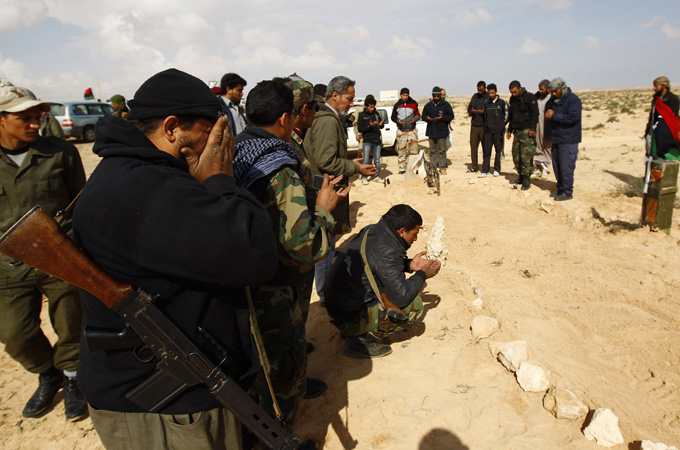‘Libyan rebels killed in NATO air strike’
NATO investigating reports that coalition jet struck pro-democracy forces in country’s east, killing at least 10.

 |
| Rebel fighters prayed at the grave of fellow rebels who were killed in what they say was a coalition air strike [Reuters] |
Pro-democracy forces in Libya say at least 10 of their fighters have been killed in a NATO air strike on the outskirts of the eastern town of Brega, as the battle rages on for control of the oil port.
NATO said on Saturday that it is investigating reports that a coalition warplane struck pro-democracy forces near the front line of the battle with fighters loyal to the Libyan leader Muammar Gaddafi.
Burnt out hulks of at least four vehicles, including an ambulance, were seen by the side of the road near the eastern entrance to the oil town on Saturday, the Reuters news agency reported. Men prayed at freshly dug graves nearby as they buried their colleagues.
 |
“Some of Gaddafi’s forces sneaked in among the rebels and fired anti-aircraft guns in the air,” Mustafa Ali Omar, a pro-democracy fighter said. “After that the NATO forces came and bombed them.”
The Libyan government, meanwhile, has produced a video said to show civilians, including women and children, in a Brega hospital. They are believed to have been wounded as they tried to escape the air strikes.
Doctors say more than 240 people have been killed and over 1,000 wounded in Misurata in the last month alone, as a counter-offensive by Gaddafi’s troops raised the number of casualties.
Intense exchanges
The reports came as pro-democracy forces claimed victory over Gaddafi troops in the battle for Brega after heavy clashes.
Fighting appeared to have subsided on Saturday morning on the outskirts of the town and only the sound of NATO fighters flying overhead disturbed the calm.
Several residents told the AFP news agency that pro-democracy forces had recaptured the town and were trying to seek out a group of pro-Gaddafi snipers who were still active.
Brega, 800 km east of the capital, Tripoli, has been the scene of intense exchanges over the past few days when pro-Gaddafi forces returned after being driven out by pro-democracy fighters.
|
Al Jazeera Laurance Lee reports on NATO’s air strike that hit a rebel convoy in Brega |
But it has been unclear since Thursday who actually held the town, with anti-government forces regrouping in Ajdabiya, 80km to the east.
Al Jazeera’s Laurence Lee, reporting from the eastern city of Benghazi, said his team was told that Gaddafi’s forces have stopped using tanks “because they can be easily spotted by NATO airplanes”.
“Instead they are using pick-up trucks with mortars on the back which look a lot more like the rebel forces.
“Both sides now are basically mired in this stretch about 200km wide on the southeast tip of the Gulf of Sirte and that situation – it seems increasingly – can’t change […] So they have – despite all the bluster and the bravado – to find some sort of accommodation […] Something’s got to give.”
Mustafa Gheriani, a Transitional National Council spokesman, told Al Jazeera’s Lee that the loss of lives is very much regretted.
“However we understand that collateral damage may also take place and we do accept it, because we look at the big picture which saving more lives.
“So a few people being victims of circumstances or of being at the wrong time or the wrong place it is more or less very bad luck.”
Ceasefire rejected
The developments came a day after the Libyan government rejected a conditional ceasefire offered by the pro-democracy transitional national council.
A Libyan government spokesman termed the conditions set by the opposition for a ceasefire “mad”, and asserted that troops loyal to Gaddafi will remain stationed where they are.
“They are asking us to withdraw from our own cities. …. If this is not mad then I don’t know what this is. We will not leave our cities,” Mussa Ibrahim, the government spokesman, said on Friday.
| IN VIDEO |
|
Al Jazeera’s Hoda Abdel-Hamid reports from the |
Earlier, the opposition had said it would agree to a ceasefire as long as Gaddafi pulled his military out of opposition-held cities and allowed peaceful protests against his government.
Mustafa Abdul-Jalil, head of the opposition’s interim governing council based in Benghazi, spoke during a joint press conference on Friday with Abdelilah Al-Khatib, the UN envoy. Al-Khatib is visiting the rebels’ de facto stronghold of Benghazi in hopes of reaching a political solution to the crisis embroiling the North African nation.
Abdul-Jalil said the opposition’s condition for a ceasefire is “that the Gaddafi brigades and forces withdraw from inside and outside Libyan cities to give freedom to the Libyan people to choose and the world will see that they will choose freedom”.
The UN resolution that authorised international air strikes against Libya called for Gaddafi and pro-democracy forces to end hostilities. Gaddafi announced a ceasefire immediately but has shown no sign of heeding it. His forces continue to attack rebels in the east, where the opposition is strongest, and have besieged the only major rebel-held city in the west, Misurata.
Abdul-Jalil said the regime must withdraw its forces and lift all sieges. He stressed the ultimate goal was still to oust Gaddafi.
“Our aim is to liberate and have sovereignty over all of Libya with its capital in Tripoli,” he said.
Forces loyal to Libya’s leader of nearly 42 years spent much of this week pushing the rebels back about 160km along the coast.
The pro-democracy forces appeared to have more communication equipment such as radios and satellite phones, and were working in more organised units, in which military defectors were each leading six or seven volunteers.
On Friday, they appointed Abdel Fatah Yunis, the former interior minister who resigned to join the opposition, as the commander of the opposition military forces combating pro-Gaddafi brigades.